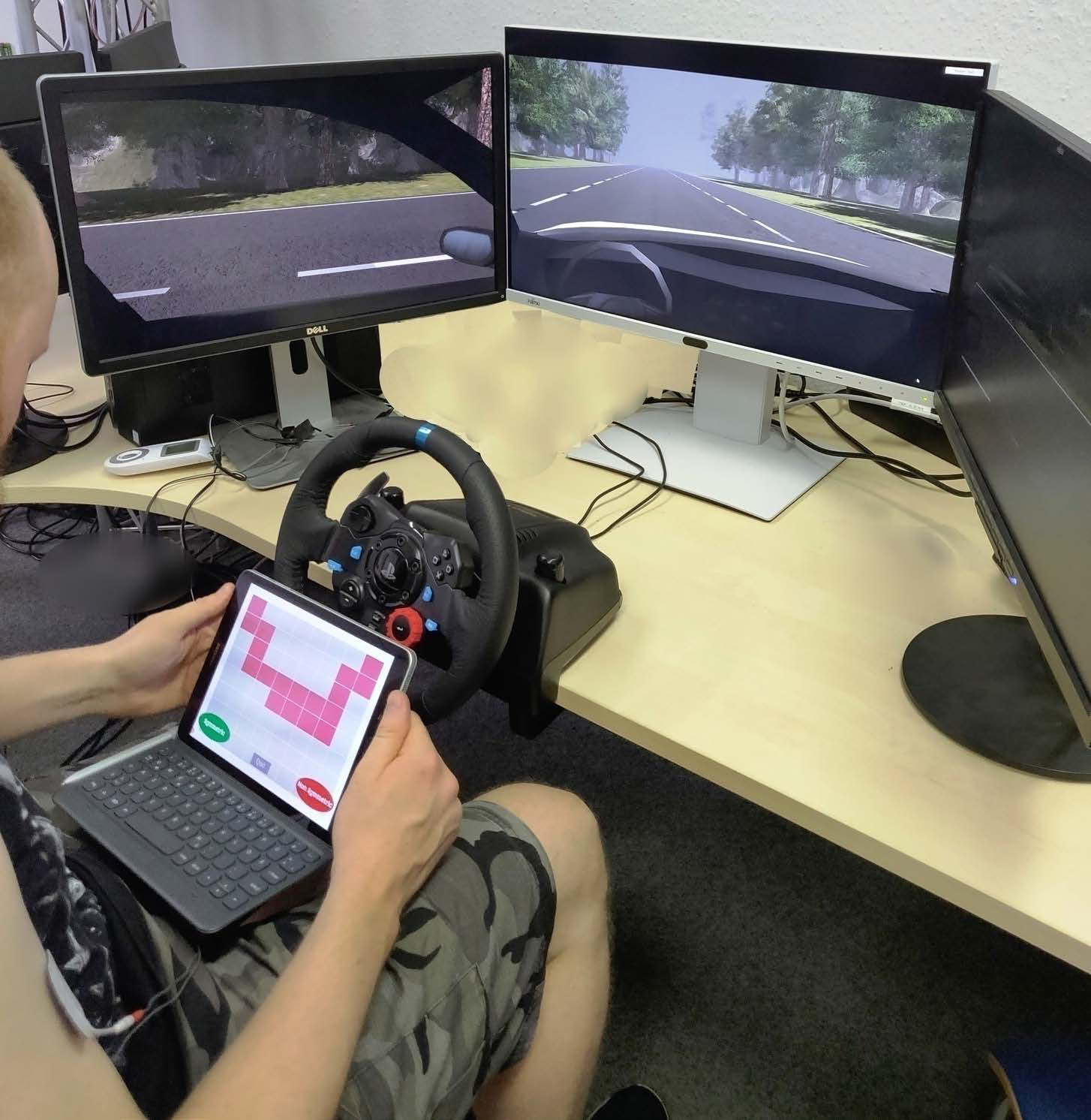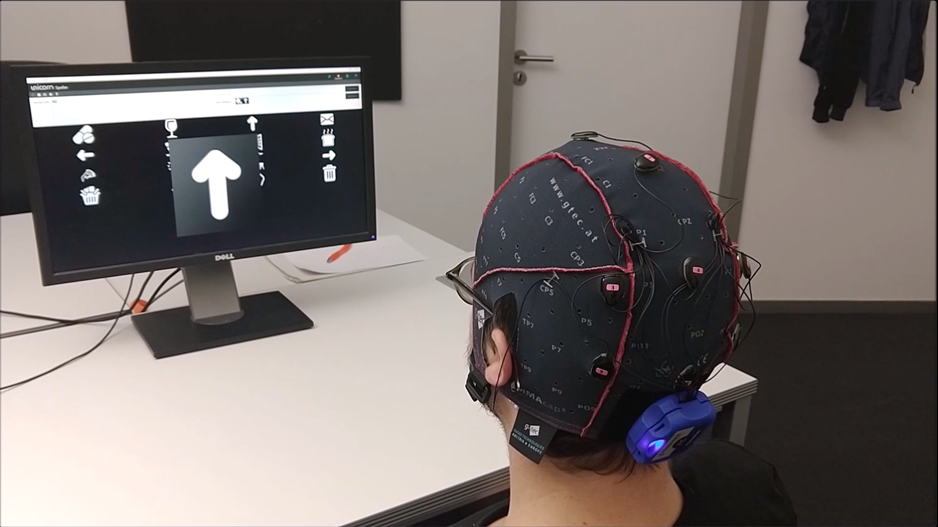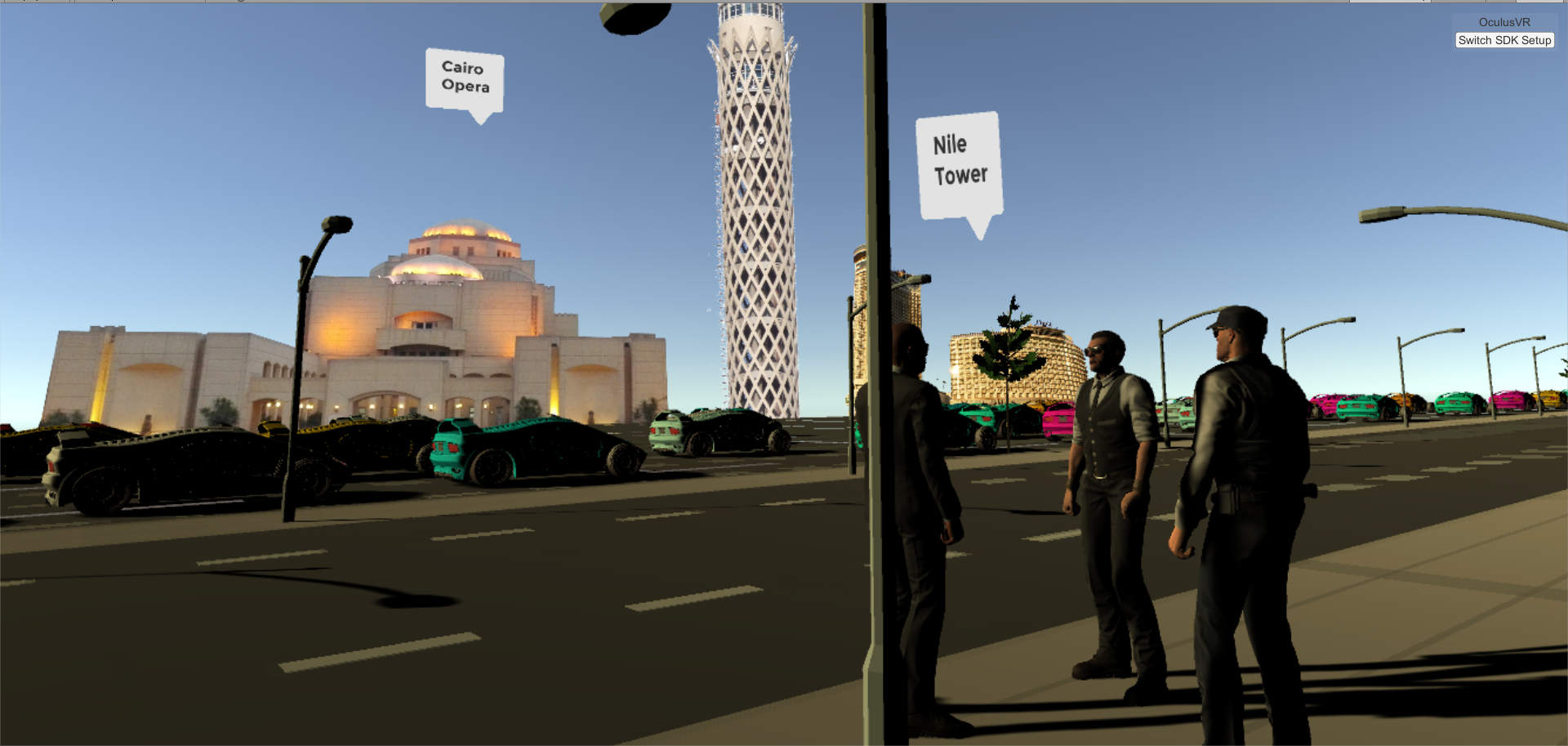Former Staff
Bio:
Sarah is a research assistant at the Human-Computer Interaction Group of the University Duisburg-Essen. She received her masters degree in Cognitive Systems from the University of Ulm. She was working as a student trainee at Daimler Research & Development in Ulm and did her Master thesis at the Max Planck Institute in Tübingen.
Publications:
- Detjen, Henrik; Faltaous, Sarah; Keppel, Jonas; Prochazka, Marvin; Gruenefeld, Uwe; Sadeghian, Shadan; Schneegass, Stefan: Investigating the Influence of Gaze- and Context-Adaptive Head-up Displays on Take-Over Requests. In: Acm (Ed.): AutomotiveUI '22: Proceedings of the 14th International Conference on Automotive User Interfaces and Interactive Vehicular Applications. 2022. doi:10.1145/3543174.3546089Full textCitationAbstractDetails
In Level 3 automated vehicles, preparing drivers for take-over requests (TORs) on the head-up display (HUD) requires their repeated attention. Visually salient HUD elements can distract attention from potentially critical parts in a driving scene during a TOR. Further, attention is (a) meanwhile needed for non-driving-related activities and can (b) be over-requested. In this paper, we conduct a driving simulator study (N=12), varying required attention by HUD warning presence (absent vs. constant vs. TOR-only) across gaze-adaptivity (with vs. without) to fit warnings to the situation. We found that (1) drivers value visual support during TORs, (2) gaze-adaptive scene complexity reduction works but creates a benefit-neutralizing distraction for some, and (3) drivers perceive constant HUD warnings as annoying and distracting over time. Our findings highlight the need for (a) HUD adaptation based on user activities and potential TORs and (b) sparse use of warning cues in future HUD designs.
- Faltaous, Sarah; Prochazka, Marvin; Auda, Jonas; Keppel, Jonas; Wittig, Nick; Gruenefeld, Uwe; Schneegass, Stefan: Give Weight to VR: Manipulating Users’ Perception of Weight in Virtual Reality with Electric Muscle Stimulation, Association for Computing Machinery, New York, NY, USA 2022. (ISBN 9781450396905) doi:10.1145/3543758.3547571) CitationAbstractDetails
Virtual Reality (VR) devices empower users to experience virtual worlds through rich visual and auditory sensations. However, believable haptic feedback that communicates the physical properties of virtual objects, such as their weight, is still unsolved in VR. The current trend towards hand tracking-based interactions, neglecting the typical controllers, further amplifies this problem. Hence, in this work, we investigate the combination of passive haptics and electric muscle stimulation to manipulate users’ perception of weight, and thus, simulate objects with different weights. In a laboratory user study, we investigate four differing electrode placements, stimulating different muscles, to determine which muscle results in the most potent perception of weight with the highest comfort. We found that actuating the biceps brachii or the triceps brachii muscles increased the weight perception of the users. Our findings lay the foundation for future investigations on weight perception in VR.
- Faltaous, Sarah; Gruenefeld, Uwe; Schneegass, Stefan: Towards a Universal Human-Computer Interaction Model for Multimodal Interactions. In: Proceedings of the Conference on Mensch Und Computer (MuC). Association for Computing Machinery, Ingolstadt, Germany 2021, p. 59-63. doi:10.1145/3473856.3474008CitationAbstractDetails
Models in HCI describe and provide insights into how humans use interactive technology. They are used by engineers, designers, and developers to understand and formalize the interaction process. At the same time, novel interaction paradigms arise constantly introducing new ways of how interactive technology can support humans. In this work, we look into how these paradigms can be described using the classical HCI model introduced by Schomaker in 1995. We extend this model by presenting new relations that would provide a better understanding of them. For this, we revisit the existing interaction paradigms and try to describe their interaction using this model. The goal of this work is to highlight the need to adapt the models to new interaction paradigms and spark discussion in the HCI community on this topic.
- Faltaous, Sarah; Janzon, Simon; Heger, Roman; Strauss, Marvin; Golkar, Pedram; Viefhaus, Matteo; Prochazka, Marvin; Gruenefeld, Uwe; Schneegass, Stefan: Wisdom of the IoT Crowd: Envisioning a Smart Home-Based Nutritional Intake Monitoring System. In: Proceedings of the Conference on Mensch Und Computer (MuC). Association for Computing Machinery, Ingolstadt, Germany 2021, p. 568-573. doi:10.1145/3473856.3474009CitationAbstractDetails
Obesity and overweight are two factors linked to various health problems that lead to death in the long run. Technological advancements have granted the chance to create smart interventions. These interventions could be operated by the Internet of Things (IoT) that connects different smart home and wearable devices, providing a large pool of data. In this work, we use IoT with different technologies to present an exemplary nutrition monitoring intake system. This system integrates the input from various devices to understand the users’ behavior better and provide recommendations accordingly. Furthermore, we report on a preliminary evaluation through semi-structured interviews with six participants. Their feedback highlights the system’s opportunities and challenges.
- Faltaous, Sarah; Neuwirth, Joshua; Gruenefeld, Uwe; Schneegass, Stefan: SaVR: Increasing Safety in Virtual Reality Environments via Electrical Muscle Stimulation. In: 19th International Conference on Mobile and Ubiquitous Multimedia (MUM). Association for Computing Machinery, Essen, Germany 2020, p. 254-258. doi:10.1145/3428361.3428389CitationAbstractDetails
One of the main benefits of interactive Virtual Reality (VR) applications is that they provide a high sense of immersion. As a result, users lose their sense of real-world space which makes them vulnerable to collisions with real-world objects. In this work, we propose a novel approach to prevent such collisions using Electrical Muscle Stimulation (EMS). EMS actively prevents the movement that would result in a collision by actuating the antagonist muscle. We report on a user study comparing our approach to the commonly used feedback modalities: audio, visual, and vibro-tactile. Our results show that EMS is a promising modality for restraining user movement and, at the same time, rated best in terms of user experience.
- Safwat, Sherine Ashraf; Bolock, Alia El; Alaa, Mostafa; Faltaous, Sarah; Schneegass, Stefan; Abdennadher, Slim: The Effect of Student-Lecturer Cultural Differences on Engagement in Learning Environments - A Pilot Study. In: Communications in Computer and Information Science. Springer, 2020. doi:10.1007/978-3-030-51999-5\_10CitationDetails
- Faltaous, Sarah; Schönherr, Chris; Detjen, Henrik; Schneegass, Stefan: Exploring proprioceptive take-over requests for highly automated vehicles. In: MUM '19: Proceedings of the 18th International Conference on Mobile and Ubiquitous Multimedia. ACM, Pisa, Italy 2019. doi:https://doi.org/10.1145/3365610.3365644PDFCitationDetails
- Faltaous, Sarah; Eljaki, Salma; Schneegass, Stefan: User Preferences of Voice Controlled Smart Light Systems. In: MuC'19: Proceedings of Mensch und Computer 2019. ACM, New York, USA 2019. doi:https://doi.org/10.1145/3340764.3344437PDFCitationDetails
- Detjen, Henrik; Faltaous, Sarah; Geisler, Stefan; Schneegass, Stefan: User-Defined Voice and Mid-Air Gesture Commands - for Maneuver-based Interventions in Automated Vehicles. In: MuC'19: Proceedings of Mensch und Computer 2019. ACM, New York, USA 2019. doi: DOI: https://doi.org/10.1145/3340764.3340798 PDFCitationDetails
- Faltaous, Sarah; Haas, Gabriel; Barrios, Liliana; Seiderer, Andreas; Rauh, Sebastian Felix; Chae, Han Joo; Schneegass, Stefan; Alt, Florian: BrainShare: A Glimpse of Social Interaction for Locked-in Syndrome Patients. In: CHI EA '19: Extended Abstracts of the 2019 CHI Conference on Human Factors in Computing Systems. ACM, New York, NY, USA 2019. PDFCitationDetails
- Sarah Faltaous, Jonathan Liebers; Yomna Abdelrahman, Florian Alt; Schneegass, Stefan: VPID: Towards Vein Pattern Identification Using Thermal Imaging. In: i-com (2019) No 18 (3), p. 259-270. doi:10.1515/icom-2019-0009PDFCitationAbstractDetails
Biometric authentication received considerable attention lately. The vein pattern on the back of the hand is a unique biometric that can be measured through thermal imaging. Detecting this pattern provides an implicit approach that can authenticate users while interacting. In this paper, we present the Vein-Identification system, called VPID. It consists of a vein pattern recognition pipeline and an authentication part. We implemented six different vein-based authentication approaches by combining thermal imaging and computer vision algorithms. Through a study, we show that the approaches achieve a low false-acceptance rate (“FAR”) and a low false-rejection rate (“FRR”). Our findings show that the best approach is the Hausdorff distance-difference applied in combination with a Convolutional Neural Networks (CNN) classification of stacked images.
- Faltaous, Sarah; Elbolock, Alia; Talaat, Mostafa; Abdennadher, Slim; Schneegass, Stefan: Virtual Reality for Cultural Competences. In: MUM 2018: Proceedings of the 17th International Conference on Mobile and Ubiquitous Multimedia. ACM, Cairo, Egypt 2018. doi:https://doi.org/10.1145/3282894.3289739PDFCitationDetails
- Elagroudy, Passant; Abdelrahman, Yomna; Faltaous, Sarah; Schneegass, Stefan; Davis, Hilary: Workshop on Amplified and Memorable Food Interactions. In: MUM 2018: Proceedings of the 17th International Conference on Mobile and Ubiquitous Multimedia. ACM, Cairo, Egypt 2018. doi:https://doi.org/10.1145/3282894.3286059PDFCitationDetails
- Faltaous, Sarah; Baumann, M.; Schneegass, Stefan; Chuang, Lewis: Design Guidelines for Reliability Communication in Autonomous Vehicles. In: AutomotiveUI '18: Proceedings of the 10th International Conference on Automotive User Interfaces and Interactive Vehicular Applications. ACM, Toronto, Canada 2018. doi:https://doi.org/10.1145/3239060.3239072PDFCitationDetails







